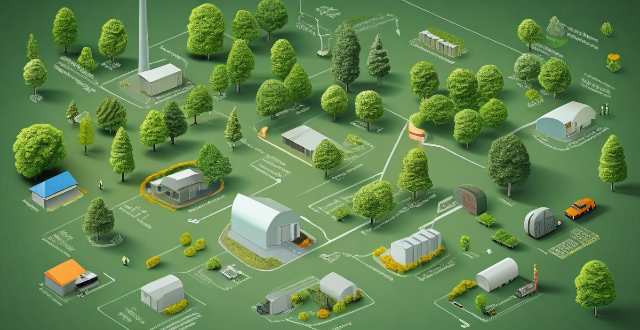The text discusses a comprehensive strategy to ensure energy security while reducing greenhouse gas emissions. It outlines four main strategies: transitioning to renewable energy sources, implementing carbon pricing mechanisms, fostering international cooperation, and encouraging sustainable practices at all levels. The transition to renewable energy sources includes investing in infrastructure for solar, wind, hydroelectric, and geothermal power, promoting energy efficiency in buildings, transportation, and industries, and increasing research and development in clean energy technologies such as battery storage, nuclear fusion, and carbon capture and storage. Implementing carbon pricing mechanisms involves imposing taxes on fossil fuels and establishing cap-and-trade systems to limit greenhouse gas emissions from industries. Fostering international cooperation includes supporting global agreements like the Paris Agreement and sharing technology and resources with developing nations. Encouraging sustainable practices at all levels involves government policies and regulations, corporate social responsibility, and public awareness and education about the importance of energy conservation and reducing emissions. The text concludes that achieving energy security and reducing greenhouse gas emissions requires technological innovation, policy implementation, international cooperation, and cultural shifts towards sustainability.

Ensuring Energy Security While Reducing Greenhouse Gas Emissions
Energy security and reducing greenhouse gas emissions are two critical challenges that the world faces today. Achieving both goals simultaneously requires a multifaceted approach that involves policymakers, industry leaders, and individuals. Here's a comprehensive strategy to ensure energy security while reducing greenhouse gas emissions:
I. Transition to Renewable Energy Sources
A. Invest in Renewable Energy Infrastructure
1. Solar Power: Solar panels can be installed on rooftops and in large solar farms to generate clean energy.
2. Wind Energy: Wind turbines can be erected in areas with consistent wind patterns to produce electricity.
3. Hydroelectric Power: Dams can harness the power of flowing water to generate electricity.
4. Geothermal Energy: Geothermal plants can use the Earth's internal heat to produce electricity.
B. Promote Energy Efficiency
1. Building Efficiency: Design buildings to minimize energy consumption through better insulation and efficient heating, ventilation, and air conditioning (HVAC) systems.
2. Transportation Efficiency: Encourage the use of electric vehicles and public transportation to reduce fossil fuel consumption.
3. Industrial Efficiency: Implement energy-efficient practices in industries to reduce waste and increase productivity.
C. Increase Research and Development in Clean Energy Technologies
1. Battery Storage: Develop better battery storage solutions for renewable energy sources to ensure a stable power supply.
2. Nuclear Fusion: Investigate the potential of nuclear fusion as a long-term solution for clean energy production.
3. Carbon Capture and Storage: Develop technologies to capture carbon dioxide emissions from power plants and store them underground.
II. Implement Carbon Pricing Mechanisms
A. Carbon Taxes
1. Tax Fossil Fuels: Impose taxes on coal, oil, and natural gas based on their carbon content to discourage their use.
2. Revenue-Neutral Taxes: Use revenues from carbon taxes to fund environmental initiatives or reduce other taxes.
B. Cap-and-Trade Systems
1. Establish Emissions Caps: Set limits on the total amount of greenhouse gases that can be emitted by industries.
2. Trading Allowances: Allow companies to buy and sell emission allowances within a capped system, creating an incentive for reductions.
III. Foster International Cooperation
A. Global Agreements
1. Paris Agreement: Support the goals of the Paris Agreement by committing to nationally determined contributions (NDCs).
2. International Climate Negotiations: Participate in international climate change negotiations to develop global strategies for emission reductions.
B. Technology Transfer and Collaboration
1. Sharing Renewable Energy Technologies: Share knowledge and resources related to renewable energy technologies with developing nations.
2. Joint Research Projects: Collaborate on research projects focused on developing new clean energy technologies and improving existing ones.
IV. Encourage Sustainable Practices at All Levels
A. Government Policies and Regulations
1. Environmental Standards: Establish strict environmental standards for industries to follow.
2. Incentives for Green Practices: Offer tax breaks or subsidies for businesses adopting sustainable practices.
B. Corporate Social Responsibility
1. Green Business Models: Encourage companies to adopt business models that prioritize sustainability over short-term profits.
2. Supply Chain Management: Hold suppliers accountable for their environmental impact and encourage them to adopt eco-friendly practices.
C. Public Awareness and Education
1. Education Programs: Integrate climate change education into school curriculums to raise awareness among young people.
2. Community Outreach: Organize community events and workshops to educate adults about the importance of energy conservation and reducing emissions.
In conclusion, ensuring energy security while reducing greenhouse gas emissions is a complex challenge that requires a combination of technological innovation, policy implementation, international cooperation, and cultural shifts towards sustainability. By taking these steps, we can move towards a future where our energy needs are met without compromising the health of our planet.